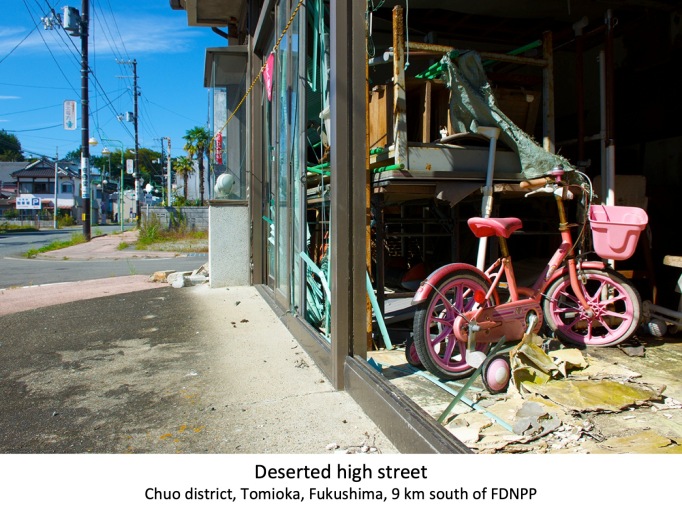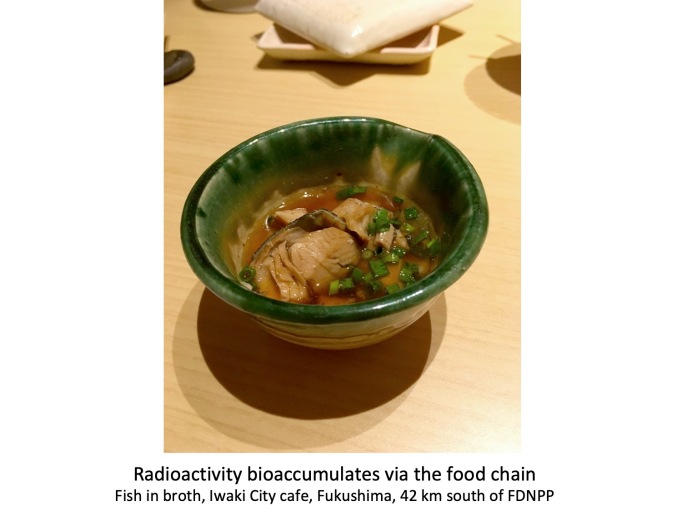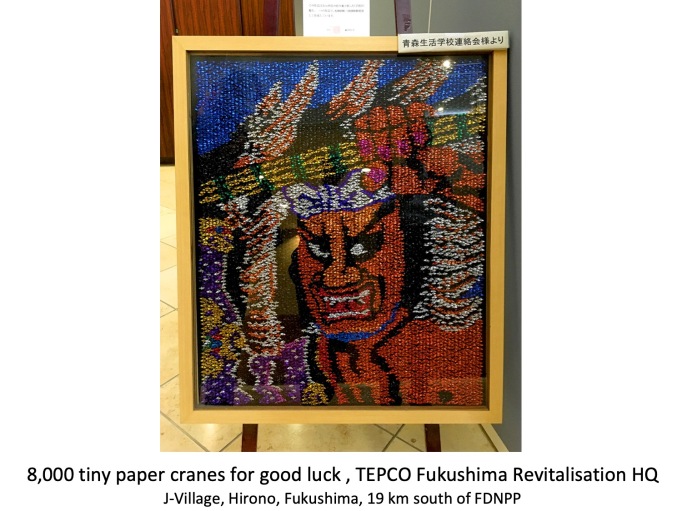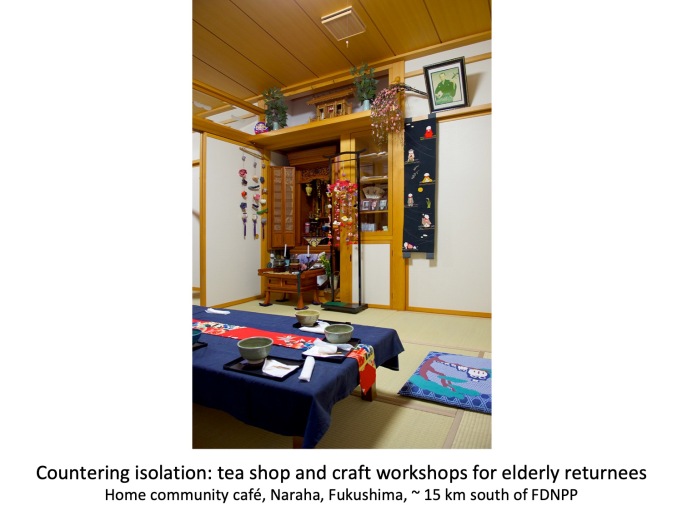Lis gave the following talk as a panellist on the Creative Resistance panel at WOW Cardiff 2018 (Women of The World festival), on 25th November 2018:


The Fukushima Daiichi nuclear catastrophe was unleashed in Japan in March 2011.

As with so many industrial disasters the devastating and ongoing human and environmental consequences have been seriously downplayed: by the Japanese government, the nuclear industry and much of the world’s corporate media.

In Japan, preparations for the 2020 Tokyo Olympics continue unabated.

Soon after 3.11, as it’s called in Japan, most of the UK corporate media outlets stopped covering Fukushima.
So it was easy to have the impression that the nuclear disaster was under control and that things were returning to normal.

It was also easy to think that because it had happened on the other side of the planet it wasn’t a problem for people living in the UK.

Then in 2013 I read that thousands of hot, used radioactive fuel rods were about to be removed from their cooling pool on the fourth floor of a damaged building.
If this risky operation went wrong and there was a meltdown, an astronomical amount of radioactivity could spread all over the northern hemisphere, carried by the wind and the ocean waters.

I learned that since 3.11, the wrecked nuclear plant had been continually polluting the ocean with massive amounts of radioactivity – initially by air then by water as well.

And then I realised that the organic seaweed which my little daughter ate virtually every day may have been contaminated with this radioactivity.
It was grown in a bay only 100km to the north.

Had I been inadvertently poisoning her?
This made the recent UK horse-meat scandal pale by comparison.

Freaked out, I began to research the disaster, obsessively, in an attempt to find out the truth.
I consulted people from all over the world, including politicians, doctors, scientists and mothers who had fled Fukushima with their children.

I was horrified to learn that there are ageing, cracking nuclear power plants, leaking away, all around the UK coastline.
Each one with vulnerable cooling pools full of highly radioactive used fuel.

Each one allowed by the government to routinely pollute our water, our air, and our food – up to a “set limit”.
And there are plans to build new ones, including Wyfa B in Anglesey and Hinkley C in Somerset.

Although we don’t often have tsunamis or big earthquakes in the UK, there are other serious risks to nuclear power plants such as cyber terrorism and climate chaos.
And human error.

Many people are scared of ionising radiation: you cannot see it, smell it, taste it or feel it.
Yet it can trigger cancer.
And not just cancer, but strokes and birth defects and many other diseases.[1]

It harms women much more than men. But it harms children, babies and embryos most of all.
And it can cause genetic damage which can be passed down through the generations.
Many scientists believe that there is no such thing as a “safe” dose.

As a result of what I was learning about Fukushima and nuclear power I felt angry, betrayed – and violated .

And I also felt compelled to take action – in solidarity with the victims, but also as an urgent warning to my fellow citizens of the UK and those of all nations which are also forced to live with the huge risks posed by the nuclear power industry.

One of the things I did was to produce Red Kimono, a series of 30 photographic portraits. Here are five of them.

I also collaborated with Thanks & Dream, a group of amazing mothers who’d evacuated with their children to Osaka, in Western Japan.
We produced booklets of their statements, letters and speeches.
More info re Red Kimono booklets

This led to an invitiation to join a study tour of Fukushima, in 2016, organised by Green Cross, the environmental NGO founded by Mikhail Gorbachov in the wake of Chernobyl.

20 milliseiverts per year is the result: an exhibition of 80 photographs, with texts in the form of detailed captions.

In most of Japan and in the rest of the world the maximum permitted dose of ionising radiation – from a nuclear power plant – to which a citizen can be exposed is 1 millisievert per year, as recommended by the ICRP – the International Commission on Radiological Protection.

But after 3.11 the maximum dose to which citizens of Fukushima can be exposed was increased to 20 millisieverts per year.
Many people in Japan and elsewhere consider this to be a serious breach of human rights.

Nothing could have prepared me for the shock of witnessing the devastation in person.

Five and a half years on, towns were still abandoned, derelict …

… and still dangerously radioactive.

In some areas massive pyramids of one-tonne bags of radioactive soil and plants filled field after field …

… with nowhere to go – even after six years.

The accelerating clicks of my Geiger counter were disturbing – sometimes inside the tour bus itself, indicating that intense gamma radiation was penetrating the sides of the bus –
and our bodies.

Thousands of people were still living in evacuation, many in tiny 20m2 portacabins, dozens of them filling car parks or playing fields …

… only allowed to spend a few hours per week at their contaminated homes.
Without their kids.

But most painful of all was witnessing the psychosocial devastation …

… as revealed by the women we met in Koriyama City.

These women knew about the risk of living in a radioactively contaminated environment.
But they were stuck there for economic reasons or because of family.

Although 60 kilometres away from Fukushima Daiichi, Koriyama, with a population of 330,00 people, was heavily contaminated.

But there was no evacuation order for the city so there were no government subsides for families to live elsewhere.

The women I met there showed extraordinary courage and strength in questioning and resisting their governments policies and advice, becoming scientifically and medically literate, learning how to measure radiation and giving each other support.

But as a fellow mother it was devastating to hear them talk about their now permanent worry about the health of their children, the safety of their food and water and even the very air they breathed.

The government was only offering medical exams to Fukushima children every two years.
These mothers were having their children examined every month – by private doctors.

And as if this were not bad enough, these mothers – and their children – faced stigma, gaslighting and isolation, from their relatives, their schools and their communities for their ongoing concern about radiation and their rejection of government advice.

For many people the burden of constantly worrying about radiation was just too great. Talking about it was becoming increasingly taboo.

So it was understandable, albeit jarring, to hear Mrs Takahara speak of letting go of her enormous anger with her government and with TEPCO – Tokyo Electric Power Company – the company which runs Fukushima Daiichi.

She didn’t want it to spoil her remaining years, so she had decided to instead accept individual responsibility for the disaster – because her town had directly benefitted from the nuclear power plant with jobs, a boost to the local economy and abundant electricity.
She said she regretted her part in “making the land uninhabitable for the next generation.”

In the summer of 2017 when I was invited by PAWB – People Against WylfaB – to bring the exhibition to Newboroughin Anglesey,
Cian Ciarán and Meilyr Tomos created an extraordinary, emotive soundscape in response to my texts and photos.

Cian and I then decided to take it further and produce an audiovisual work which could be screened as part of the exhibition.
Joel, of creative collective ffloc, cut together some of my film footage and texts with newsreel and interview clips and created some brilliant special effects.
20 millisieverts per year film

The film includes a powerful appeal by Mrs. Aoki, a former High School principle from Tomioka, who may never be able to return home:
”Please learn from Fukushima. Please learn from our mistake. You do not want to apologise to your own children, to your grandchildren for making the wrong choice before they were even born … I believe no one in this world should go through what Fukushima is going through right now. I deeply hope my voice helps you make a wise decision.’’
[1] Cardiovascular; endocrine disorders such as thyroid & diabetes; lowered immunity; autoimmune such as ME; reduced brain function, fertility problems; cataracts; early signs of radiation poisoning are chronic gushing nosebleeds, rashes, digestive disorders, lethargy, allergies.
Since 3.11 there has been a surge of illnesses in North Eastern Japan such as chronic gushing nosebleeds, gastric disorders, lowered immunity and thyroid cancers*. But doctors have been forbidden from saying that radiation is the cause.
*currently more than 200 out of the ~ 300,000 under 18s being tested = 667 per million. Before 3.11 it was 1-3 per million in this age group.
